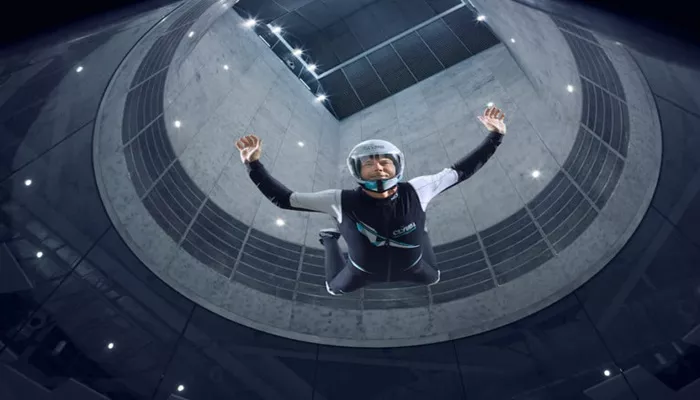Indoor skydiving tunnels simulate the experience of freefall skydiving in a controlled environment. Instead of jumping from an airplane, participants float on a vertical column of fast-moving air inside a transparent tube. This thrilling activity allows people to experience the sensation of flying without the risks and logistics of outdoor skydiving. The core of indoor skydiving is the vertical wind tunnel, which generates a powerful upward airflow strong enough to support a person’s body weight, enabling them to float and maneuver in mid-air.
What Is An Indoor Skydiving Tunnel?
An indoor skydiving tunnel is a large vertical cylinder, often made of transparent materials like glass or acrylic, allowing spectators to watch the flyers inside. The tunnel is connected to a system of powerful fans and air ducts, which create a continuous airflow that moves upward through the center of the tunnel. This airflow mimics the freefall conditions of outdoor skydiving by producing a steady wind speed that counteracts gravity, keeping the flyer suspended in the air.
How Do Indoor Skydiving Tunnels Work?
The Basic Principle: Airflow and Lift
The fundamental operation of an indoor skydiving tunnel relies on aerodynamic principles. When air flows upward at high speed, it creates an upward force called lift. This lift opposes the downward pull of gravity on the flyer’s body. By adjusting their body position, flyers can control how much lift they generate, allowing them to float, move laterally, or spin within the airflow.
Air Movement: Fans and Air Circulation
Indoor skydiving tunnels use very powerful fans to move large volumes of air. These fans are usually located at the top of the tunnel and work by pulling air from the flight chamber and pushing it through ducts around the tunnel’s perimeter, then directing it back up through the flight chamber. This creates a closed-loop airflow system, where air continuously circulates, maintaining a steady vertical wind column.
The Flight Chamber and Airflow Control
The flight chamber is the vertical tube where flyers float. It is designed to channel the airflow smoothly and evenly. To achieve this, the tunnel incorporates several engineering features:
Flow Conditioning: Before entering the flight chamber, air passes through honeycomb structures and mesh screens that straighten the airflow and reduce turbulence. This ensures the air moves uniformly, providing stable lift for flyers.
Venturi Effect: The tunnel narrows at the flight chamber, accelerating the airflow to reach speeds typically between 120 and 180 miles per hour, which is necessary to support human body weight in freefall positions.
Diffuser Section: After the flight chamber, the tunnel widens gradually to slow down the air and reduce noise and energy loss.
Safety Features
The flight chamber floor is padded to protect flyers if they lose balance and fall. The transparent walls allow instructors to monitor flyers closely and provide immediate assistance if needed.
Detailed Operation Principle
1. Air Intake and Fan Operation
Large, multi-bladed fans powered by electric motors generate the airflow. These fans can be over 12 feet in diameter and are capable of moving air at speeds sufficient to counteract gravity on a human body. The fans pull air from the flight chamber and push it through ducts around the tunnel, creating a continuous circulation loop.
2. Airflow Conditioning and Acceleration
As air circulates, it passes through flow straighteners like honeycomb grids that align air molecules to flow parallel and reduce swirls or eddies. Mesh screens further smooth the airflow to ensure a steady, laminar flow. The tunnel’s narrowing at the flight chamber (Venturi section) accelerates the air to the required velocity for flight.
3. Flight Chamber Dynamics
Inside the flight chamber, the upward airflow creates a cushion of air that supports the flyer. Flyers position their bodies to maximize lift by increasing surface area against the airflow. For example, arching the back and spreading arms and legs increases resistance to the airflow, creating more lift and stability. Conversely, tucking limbs reduces surface area and causes the flyer to descend.
4. Control and Maneuverability
Flyers control their movement by adjusting body posture. Small changes in arm or leg positions alter airflow around the body, enabling turns, flips, and vertical movement. The stable airflow allows precise control similar to outdoor skydiving but in a safer, confined space.
Summary Table: Key Components and Their Functions
| Component | Function |
| Fans | Generate high-speed airflow, pulling and pushing air |
| Air Ducts | Direct airflow around the tunnel in a closed-loop system |
| Honeycomb Grids | Straighten airflow, reduce turbulence |
| Mesh Screens | Smooth airflow, break up eddies |
| Venturi Section | Narrow tunnel to accelerate airflow to flight speed |
| Flight Chamber | Vertical tube where flyers float and maneuver |
| Padded Floor | Safety cushion for flyers |
| Transparent Walls | Allow observation and safety monitoring |
Conclusion
Indoor skydiving tunnels work by creating a powerful, controlled vertical airflow that simulates the freefall conditions of outdoor skydiving. Through a combination of powerful fans, aerodynamic flow conditioning, and precise tunnel design, these tunnels generate a stable column of air strong enough to support human flight. Flyers use their body position to interact with this airflow, enabling them to float, turn, and move freely in a safe indoor environment. This technology has made the thrill of skydiving accessible year-round, regardless of weather or altitude.

